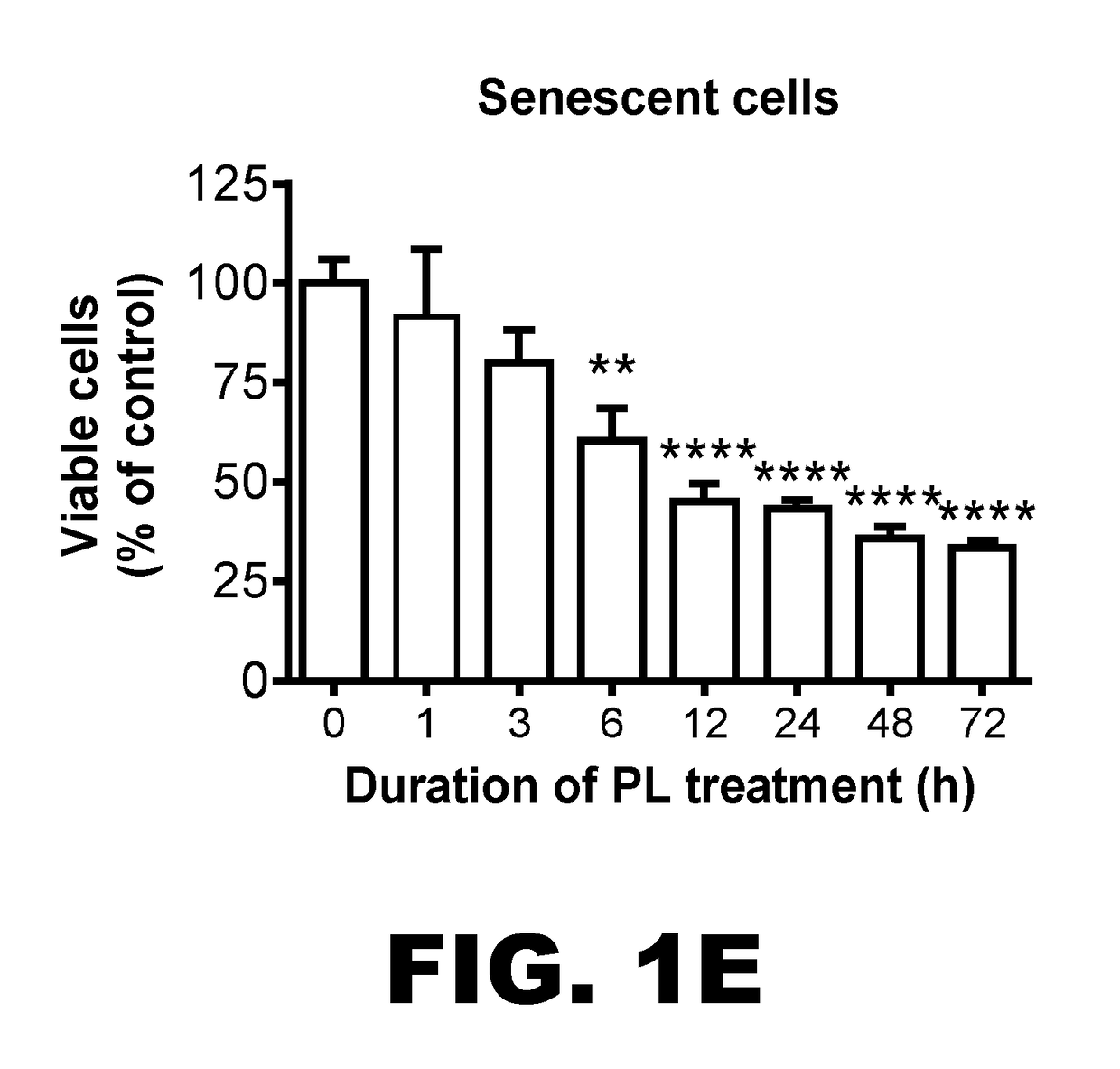Compositions and methods for selectively depleting senescent cells
a technology of senescent cells and compositions, applied in the field of compositions of drug components, heterocyclic compound active ingredients, organic chemistry, etc., can solve the problems of no drug that can selectively deplete senescent cells, tissue degeneration, delay of various age-related pathologies and disorders,
- Summary
- Abstract
- Description
- Claims
- Application Information
AI Technical Summary
Benefits of technology
Problems solved by technology
Method used
Image
Examples
example 1
umine (PL) Selectively Kills Senescent WI38 Cells in a Dose- and Time-Dependent Manner
[0419]Normal W138 cells (FIG. 1A), IR-induced senescent cells (FIG. 1B) and replicative senescent cells (FIG. 1C) were incubated with increasing concentrations of PL. At 72 hours post-treatment cell viability was measured. Concentrations of PL up to 10 μM had no significant effect on normal WI38 cells (FIG. 1A). However, concentrations as low as 5 μM PL significantly reduced the number of viable cells in both IR-induced senescent cells and replicative senescent cells (FIG. 1B,C). IR-induced senescent WI38 cells were treated with 10 μM PL and viable cells were measured at 0, 1, 2, 3, 6, 12, 16, 24, 48 and 72 hours after treatment (FIG. 1D) or the cells were incubated with 10 μM PL for 1, 3, 6, 12, 24, 48 or 72 hours and cell viability was measured at 72 h (FIG. 1E). There was a significant reduction in viable cells from 6 hours on in both treatment scenarios (FIG. 1D,E).
example 2
ively Increases ROS Production in Senescent Cells
[0420]PL selectively targets senescent cells as measured by the LD50 value. Other ROS target drugs such as auranofin, buthionine sulfoximine, and decyl-triphenylphosphonium have approximately equivalent LD50 values between normal and senescent cells (Table 1).
[0421]PL selectively increases ROS in senescent WI38 in a time-dependent manner. Normal (FIG. 2A) and IR-induced senescent WI38 cells (FIG. 2B) were incubated with vehicle (Veh), 200 mM H2O2 for 30 min as a positive control, or 10 μM PL. Reactive oxygen species (ROS) was measured at various times (1, 3, 6, 12, 24 hours) after PL treatment and expressed as percent of control. Data are presented as mean±SE of three independent assays. PL significantly increased ROS production at 24 hours.
TABLE 1LD50 value of ROS target drugs and PL against normal and various senescentWI38 cells.LD50LD50 (IR-LD50(normal)senescent)(Replicative)Ratio(μM)(μM)(μM)MOA or Target(normal / senescent)Auranofin...
example 3
Cysteine (NAC) but not the Pan-Caspase Inhibitor Qcd Attenuates PL Induced Cell Death in Senescent Cells
[0422]IR-induced senescent WI38 cells were pre-treated with the pan-caspase inhibitor Q-VD-OPh (20 μM) (FIG. 3B) or the antioxidant NAC (1 mM) (FIG. 3A) for 2 hours and then incubated with vehicle (VEH) or 10 μM PL for 72 h. Cell viability was measured and expressed as percent of control. Data are presented as mean±SE of three independent assays. NAC selectively inhibited PL induced cell death in senescent cells
PUM
| Property | Measurement | Unit |
|---|---|---|
| weight fraction | aaaaa | aaaaa |
| weight fraction | aaaaa | aaaaa |
| weight fraction | aaaaa | aaaaa |
Abstract
Description
Claims
Application Information
 Login to View More
Login to View More - R&D
- Intellectual Property
- Life Sciences
- Materials
- Tech Scout
- Unparalleled Data Quality
- Higher Quality Content
- 60% Fewer Hallucinations
Browse by: Latest US Patents, China's latest patents, Technical Efficacy Thesaurus, Application Domain, Technology Topic, Popular Technical Reports.
© 2025 PatSnap. All rights reserved.Legal|Privacy policy|Modern Slavery Act Transparency Statement|Sitemap|About US| Contact US: help@patsnap.com



